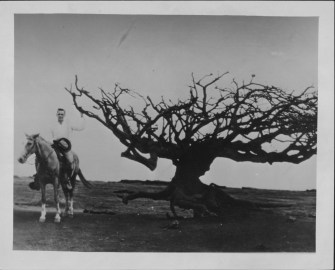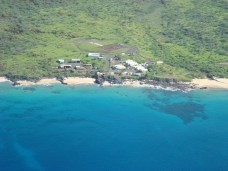“An architect has to be a bit of a sociologist, lawyer and psychologist. He has to know human nature.” (Vladimir Ossipoff)
Vladimir Ossipoff was a prominent architect in the Islands, working between the 1930s and 1990s. He was recognized locally, nationally and internationally for his designs. He is best known for his contribution to the development of the Hawaiian Modern movement.
This style is characterized by the work of architects who “subscribed to the general modernity of the International Style while attempting to integrate the cultural and topographical character of the (Hawaiian) region.” (Sakamoto)
This very frequently included an attempt to integrate the interior of buildings with the outdoors, and minimizing the dividing line between the building and the site.
Ossipoff was born in Russia on November 25, 1907 and moved with his family to Japan, where his father was a military attaché in Tokyo during the post Russo-Japanese War period. The family remained in Japan during the Russian revolutionary period, and Ossipoff attended school in Tokyo and Yokohama.
In 1923, Ossipoff and his mother and siblings moved to Berkeley, California where he graduated from Berkeley High School in 1926. He continued on to the University of California at Berkeley, studying architecture. He earned a Bachelor’s in Architecture in 1931, and after losing his first job out of school due to the Great Depression, sailed for Honolulu the same year.
Within a few months of taking up residence in Honolulu, he found work with the architect Charles W Dickey working on the Immigration Station at Honolulu Harbor. He worked as in-house designer for developer Theo H. Davies, designing more than twenty-five residences between 1932 and 1935, before opening his own firm in early 1936.
His early work included mainly upscale homes with Hawaiian elements, though he sometimes included International Style or Modern influences, and still more infrequently designed strict interpretations of these styles.
The 1937 Ossipoff-designed, four-acre Boettcher Estate site on Kailua Beach was acquired by the City and County of Honolulu in 1978. It was restored and is now part of the Kalama Beach Park.
During World War II, Ossipoff worked for the government, with the Contractors, Pacific Naval Air Bases and quickly reopened his office at the end of the war.
About 1947-48, Ossipoff and several other Honolulu architects associated as Fisk, Johnson, Ossipoff and Preis, Associated Architects, combining the resources of their offices in order to obtain large commissions.
The association split up gradually, around 1952-53, as the members withdrew to work on their own projects. In 1956-57, Ossipoff expanded his office, hiring several younger architects, including Sidney Snyder, Jr., Alan Rowland and Gregory Goetz, and in 1973, the firm was incorporated as Ossipoff, Snyder, Rowland and Goetz.
Between the end of the World War II and the 1970s, Ossipoff produced most of the Hawaiian Modern design that he is known for today, and became a leading figure in the Hawaiian Modern movement.
Although he practiced at a time of rapid growth and social change in Hawai`i, Ossipoff criticized large-scale development and advocated environmentally sensitive designs, developing a distinctive form of architecture appropriate to the lush topography, light and microclimates of the Hawaiian Islands.
Ossipoff’s inspiration was Hawaiian architecture, in particular the lanai, an open-sided, freestanding and lightly-roofed structure usually buffered from the weather by foliage. His use of a shaded lanai as the primary living area, created an inviting indoor-outdoor space around an intimate garden. (NY Times)
The adaptation of Modernist building forms to Hawaiian living conditions was to become more pronounced in Ossipoff’s later buildings, and also eventually evolve into his signature style.
Ossipoff’s design employs deep overhangs, carefully oriented windows and vents to create a naturally ventilated structure that is permeable to the powerful Pacific trade winds yet protected from rain and excessive sunlight. (NY Times)
His design values were consistent with recommendations made nearly three decades earlier by the American cultural critic Lewis Mumford in his report “Whither Honolulu” (1938) which was commissioned by the city’s Parks Department.
Mumford cautioned that while much of Honolulu’s natural virtues had “… already been spoilt. More disastrous results may follow unless steps are taken at once to conserve Honolulu’s peculiar advantages such as its connections to the ocean and to create buildings which take full advantage of the balmy trade winds and exceptional foliage that are unique to Hawaiʻi.” (DAM)
His work has been featured in local, national, and international publications, and he won numerous local design awards. Ossipoff served, two times, as president of the Hawaiʻi chapter of the American Institute of Architects (AIA), and also served as the AIA’s northwest regional director in 1972 – the first architect from Hawaiʻi to do so.
He was asked to serve as a visiting critic at the Cornell University School of Architecture, and as a juror for the Sunset magazine Home Design Awards in 1959. In 1964, he chaired the jury for the Mount Olympus International Design. (Lots of information here is from Jones, NPS.)
Follow Peter T Young on Facebook
Follow Peter T Young on Google+
Follow Peter T Young on LinkedIn
Follow Peter T Young on Blogger












































